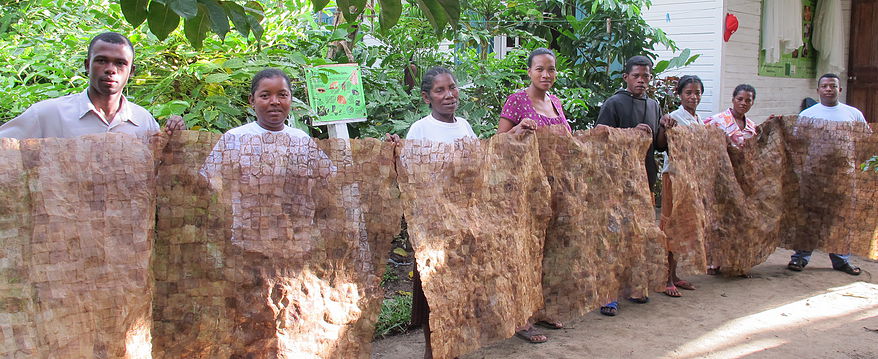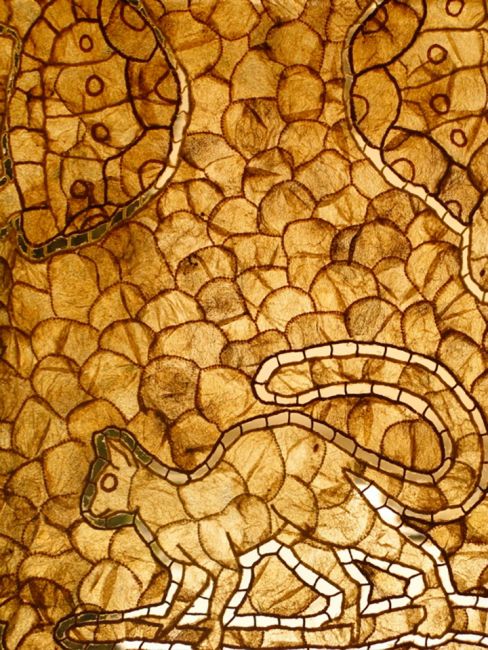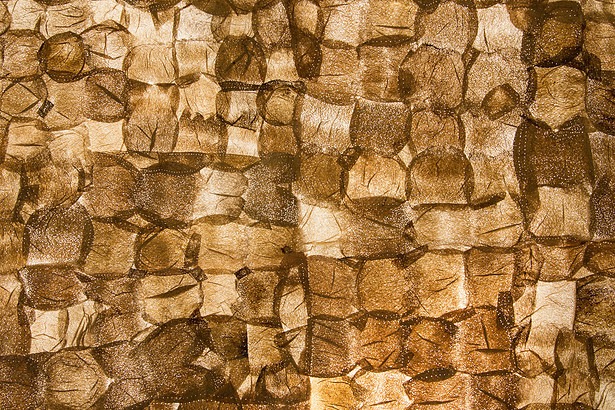Previous posts to the MAHB Blog have considered how art can be used to bring attention to the themes of sustainability, environmental degradation and extinction, but can the artwork itself – a sculpture, sketch, painting, collage –be composed of products produced in ways that minimize our human footprint on the environment?
For example, since 2000, Aveda has given consumers the opportunity to transform the cosmetics industry. Although not all companies follow their example, Aveda’s cosmetics are at least 50% derived from plant or non-petroleum products and sourced so as not to negatively impact the ecosystems from which they are derived.
The International NGO, Conservation through Poverty Alleviation, International (CPALI) and its partner, Sehatry are aiming to provide a similar opportunity to artists. The Wild Silk project of SEPALI Madagascar facilitates the production of native, no-kill silk textiles that promote habitat recovery and income generation for local farmers and artisans.

Farmers living on the borders of the Makira and Masoala Protected Areas plant native and fast growing primary rainforest trees (Polycias bakeriana) in former clear-cut zones, intercrop them with edible plants, and use them to raise native silkworms (Antherina suraka) to produce silk. This no-kill production method results in uniquely beautiful silk fibers that are refined into shimmering textiles artisans can sew, embroider, paint, or make into jewelry and other works. This creates a native ecosystem of production from which the farmers can improve their own lives with their own resources. CPALI is building markets for these new art materials in the US and Europe and returning all market profits to the program and participating farmers in Madagascar.

The cocoon “paper” has a unique texture and subtle, natural, color shifts that depend on the angle that the sun strikes them. Low-density cocoon panels obscure what is behind the silk yet still allow light to penetrate. High-density panels hide what is behind them but provide a warm glow.
Recently SEPALI Madagascar has been experimenting with color. The papers are dyed with acid dyes. All of the dye is absorbed by the paper or textile leaving the dye water clear and safe. Large panels of the patchwork of cocoon silk made by SEPALI are reminiscent of the work of El Anatsui and just waiting for an artist to develop them fully. One artist, Mandy Coppes-Martin, has used SEPALI silk in her environmentally themed sculptures and collages. (Mandy Coppes-Martin’s work will be featured here next week).
For Mamy Ratsimbazafy, the director and founder of SEPALI Madagascar, the silk project combines his passion for entomology with his dedication to, and advocacy for, the rural communities of Madagascar.
“In addition to the wealth of biodiversity in this region, people are also very generous and they believe that it is very important to safeguard the biodiversity in this community –in their community, in my community also– I believe that if we continue to train them that we can set up a very good conservation and livelihood program.” –Mamy Ratsimbazafy
Mamy Ratsimbazafy and his wife, Lalaina Raharindimby have been the heart and soul of the organization since its creation in 2009. Together they have built a thriving community network of farmers, artisans and dedicated staff who are deeply invested in creating a better future for rural Malagasy communities.
With their captivating glint and rich textures, the silk textiles produced through this process are truly unique. Local and international artists alike have taken on the opportunity, and challenge, of incorporating this incredible material into their work. In doing so, they engage with the themes of sustainability and social equity in a different way –by reworking materials created by a process promoting sustainability and social equity into pieces that inspire us all to reconsider what can become beautiful.
If you would like to see more wild silk artwork, please visit CPALI/SEPALI’s gallery site, Wild Silk Secrets. To see CPALI/SEPALI in action and visit with SEPALI farmers, check out the SEPALI video. If you would like to incorporate wild silk papers and textiles into your own work they can be purchased at www.wildsilkmarkets.com. Silk and raffia products are available in paper sizes, textile sizes and 100% of all profits are returned directly to Madagascar to support conservation based livelihoods.
This post is part of the MAHB’s Arts Community space –an open space for MAHB members to share, discuss, and connect with artwork processes and products pushing for change. Please visit the MAHB Arts Community to share and reflect on how art can promote critical changes in behavior and systems and contact Erika with any questions or suggestions you have regarding the new space.
MAHB Blog: https://mahb.stanford.edu/blog/wild-silk/
The views and opinions expressed through the MAHB Website are those of the contributing authors and do not necessarily reflect an official position of the MAHB. The MAHB aims to share a range of perspectives and welcomes the discussions that they prompt.
